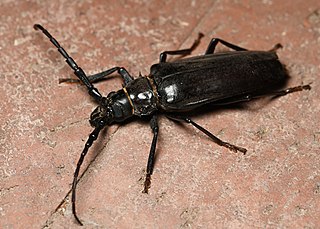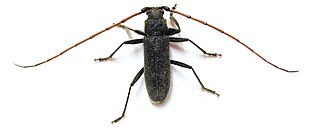
The Curculionidae are the family of the "true" weevils. They are one of the largest animal families, with 6,800 genera and 83,000 species described worldwide. They are the sister group to the family Brentidae.

The longhorn beetles (Cerambycidae), also known as long-horned or longicorns, are a large family of beetles, with over 35,000 species described. Most species are characterized by extremely long antennae, which are often as long as or longer than the beetle's body. In various members of the family, however, the antennae are quite short and such species can be difficult to distinguish from related beetle families such as the Chrysomelidae. The scientific name of this beetle family goes back to a figure from Greek mythology: after an argument with nymphs, the shepherd Cerambus was transformed into a large beetle with horns.

The emerald ash borer, also known by the acronym EAB, is a green buprestid or jewel beetle native to north-eastern Asia that feeds on ash species. Females lay eggs in bark crevices on ash trees, and larvae feed underneath the bark of ash trees to emerge as adults in one to two years. In its native range, it is typically found at low densities and does not cause significant damage to trees native to the area. Outside its native range, it is an invasive species and is highly destructive to ash trees native to Europe and North America. Before it was found in North America, very little was known about emerald ash borer in its native range; this has resulted in much of the research on its biology being focused in North America. Local governments in North America are attempting to control it by monitoring its spread, diversifying tree species, and through the use of insecticides and biological control.

Cleridae are a family of beetles of the superfamily Cleroidea. They are commonly known as checkered beetles. The family Cleridae has a worldwide distribution, and a variety of habitats and feeding preferences.

Xanthocryptus novozealandicus, the lemon tree borer parasite, is a wasp in the family Ichneumonidae. It is a native insect of New Zealand. It is also found in Australia and New Guinea. Females hunt for larvae of wood-boring beetles around March, including the lemon tree borer, a native cerambycid that tunnels into citrus trees, grapes and many native species. When a suitable host is found, the female pushes her ovipositor through the wood and injects her eggs into the grub. This has the incidental benefit of helping to control some pests. X. novozealandicus prefers to prey on second year lemon tree borer larvae. This specific parasite prefers to prey on larger second year larvae due to its larger size.

A pheromone trap is a type of insect trap that uses pheromones to lure insects. Sex pheromones and aggregating pheromones are the most common types used. A pheromone-impregnated lure, as the red rubber septa in the picture, is encased in a conventional trap such as a bottle trap, Delta trap, water-pan trap, or funnel trap. Pheromone traps are used both to count insect populations by sampling, and to trap pests such as clothes moths to destroy them.

Scolytus is a genus of bark beetles. It includes several species notorious for destroying trees in the forests. The Dutch elm disease is spread in North America by two species : the native elm bark beetle, Hylurgopinus rufipes, and the European elm bark beetle, Scolytus multistriatus. In Europe, while the aforementioned Scolytus multistriatus again acts as vector for infection, it is much less effective than the large elm bark beetle Scolytus scolytus.

The banded alder borer, Rosalia funebris, is a member of the very diverse family of longhorn beetles.

The cottonwood borer is a species of longhorn beetle found in the United States east of the Rocky Mountains that feeds on cottonwood trees. It is one of the largest insects in North America, with lengths reaching 40 millimetres (1.6 in) and widths, 12 mm (0.47 in). It is the only species in the genus Plectrodera.

Asemum striatum, the black spruce borer, is a beetle species belonging to the family Cerambycidae, subfamily Spondylidinae.

Derobrachus hovorei is a species of beetle in the family Cerambycidae, known variously as the palo verde beetle, palo verde root borer, or palo verde borer beetle. For over 100 years, this species was confused with the related species Derobrachus geminatus, and only recognized and given its own name by Santos-Silva in 2007; essentially all literature prior to 2007 therefore incorrectly uses the name geminatus for this species. It is a longhorn beetle native to the southwestern United States and northern Mexico which derives its common name from the palo verde tree, and it is one of the largest beetles in North America, reaching up to three and a half inches in length. Adults are black or brown in colour, have long antennae, and spines on the thorax. They have wings and can fly, albeit awkwardly at times. Mature beetles emerge in the summer to mate. Adults do not eat, and rely solely on their energy reserves until they die in about one month. While not harmful to humans, they can bite in self-defense.

Batocera boisduvali, the great fig tree borer, is a species of flat-faced longhorn beetle belonging to the subfamily Lamiinae of the family Cerambycidae.

Xylorhiza adusta is a species of beetles in the longhorn beetle family (Cerambycidae).
Styloxus fulleri is a species of beetle in the family Cerambycidae. It was described by George Henry Horn in 1880.

Phoracantha semipunctata, the Australian Eucalyptus longhorn, is a species of beetle in the family Cerambycidae. Native to Australia, it has now spread to many parts of the world, including practically all countries where tree species of Eucalyptus have been introduced. It has been classified as an invasive pest species of eucalyptus outside Australia.
Strophiona nitens, the chestnut bark borer, is a species of flower longhorn in the beetle family Cerambycidae. It is found in North America.

Atimia confusa, known generally as the small cedar borer or small cedar-bark borer, is a species of long-horned beetle in the family Cerambycidae. It is found in North America.
Twig borer refers to a number of species of beetles and moths that chew holes into small branches of trees and shrubs. Many of these insects are agricultural pests. Animals that are called twig borers include:

Stromatium barbatum is a species of beetle in the family Cerambycidae. This species is native to the Oriental region. It has been recorded in mainland India, the Andaman Islands, Myanmar, Sri Lanka, Mauritius, Réunion and Seychelles. This species has also spread to continental Africa and Madagascar.

Neoplocaederus obesus, commonly known as Cashew stem borer or Red cocoon-making longhorn, is a species of longhorn beetle native to South Asian and South East Asian countries.

















